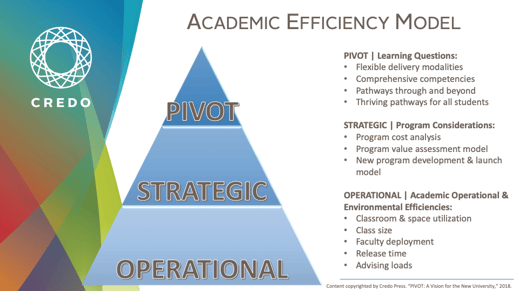
April 30 2019
Student learning is our enterprise; it’s why our institutions exist. The heart of our business is the development and execution of learning that results in transformed students who are prepared for and confident about their contribution to society and their ability to secure a meaningful life. With that student transformation at the center of institutional investment, cost across the academic unit must be closely examined, and university leaders must be ready to evaluate, limit, or eliminate any academic program if the numbers, trends, and projections are not satisfactory for the expense to the institution. But when we approach that enterprise with efficiency as the only measure, we risk the demise of quality. Instead, our colleague Dr. Joretta Nelson strongly recommends that any discussion about costs are driven by:
- an agreed-upon definitions of program excellence,
- a robust publicly available data, and
- a practice of allocating resources based on demonstrated quality.
Within that environment, the dependent variable is not just net revenue per full-time enrolled student, but more importantly, the quality of student-learning outcomes. That environment drives innovative and experimental thinking rather than protectionism and fear. There are three levels of work that should be taking place at all times related to academic efficiencies:
Level One: Operational
An operational-level approach analyzes distributions of both time and space with an end-goal of maximizing class sizes, frequency of offerings, and faculty deployment. This first stage of analysis typically generates substantive resource savings as academic administration recognizes the costs of multiples course sections, poorly designed course rotations, costly faculty release time inequities, and unbalanced advising loads. This is also the level for classroom-utilization analyses; spaces not fully utilized at maximum capacity or time-schedule can create the illusion that additional space must be built or rented when instead, adjustment of schedule and release of building or classroom “ownership” is required: i.e., creating departmental willingness to share spaces across disciplines.
Level Two: Strategic
A strategic-level approach represents both the analysis of program costs but more importantly, the rubrics for program development. At this stage, the institution comes to agreement on how programs will be valued. This process of determining which variables will be utilized, and how they will be weighted, is most effectively implemented if developed collaboratively between administration and faculty. Many institutions focus only on academic programs in this level and miss the opportunity to look at all learning programs on campus. This means including advising, academic support, high-impact practices, and all components of the co-curricular experience. While existing programs are the initial focus, the true value in adopting this practice is in how new programs are evaluated and launched.
Level Three: Pivot
This the highest stage of academic strategic thinking where larger learning questions are considered, such as:
- What is the value of the common core?
- Why do students need this particular number of credit hours to graduate?
- What benefits might we see from increasing transferability of credits between institutions?
- What would it look like if we added co-curricular portfolios that reflected deeper layers of learning?
- What hybrid modalities would allow for shortened time to degree?
If the goal is continued development of margin for the sake of mission, the existing models of educational delivery must evolve. Efficiency must be an outcome of innovative, effective learning experiences.
No Margin, No Mission Challenge Questions
-
In a budget deficit, are adjustments made that create efficiencies in the organization rather than impact to learning?
-
Is each department or division at your institution asked to rebuild and justify its budgets annually?
-
Have you taken a close look at academic efficiencies in the last three years?
-
Are clear business plans developed to inform decisions about new programs and initiatives?
-
Is financial modeling used when examining the viability of a new program?
-
Is there an efficient and effective process for eliminating programs that don’t meet original goal measures?
How is efficient is your academic programming? Is your advising module the best for your student populations? Credo offers a targeted selection of Academic Programming Solutions designed to enhance your academic efficiencies, prioritize programming, and make sure your students get the most out of their advising experience. Visit our Academic Programming Solutions page to find out more or Contact Us to start a conversation about improving academic efficiencies.
Are you enjoying this blog series? If so, you can get the complete text by ordering "PIVOT: A Vision for the New University." Go beyond excerpts and get the full story by ordering your copy today.
© Credo and www.credohighered.com, 2018. Unauthorized use and/or duplication of this material without express and written permission from this site’s author and/or owner is strictly prohibited. Short excerpts and links may be used, provided that full and clear credit is given to Credo, Credo Press, and www.credohighered.com with appropriate and specific direction to the original content. Please email info@credohighered.com for information on how to obtain a full copy of Pivot: A Vision for the New University or for permission to use excerpts from the book and/or blog series.
Related Blog Posts
Recent Posts
- Richard Dunsworth, J.D., To Receive 12th Annual Courageous Leadership Award December 16 2024
- Meet the 2024 Credo Values Award Recipients August 27 2024
- What is Executive Coaching, Really? June 25 2024
- Credo & The Constructive Dialogue Institute Announce A New Partnership For Higher Education Leadership Development March 7 2024
- Celebrating Women And Gender-Diverse Learners & Leaders February 28 2024
Categories
- Strategy
- Leadership
- Student Success
- Student Success & Retention
- Enrollment
- Pivot
- Strategic Planning
- Leadership Development
- News
- Strategic Enrollment
- Campus Planning and Architecture
- Moving the Needle
- Data
- Research
- Retention
- Campus Master Planning
- Enrollment & Financial Aid
- Academic Programming
- Campus Planning
- Thriving
- Admitted Student Research
- Architecture
- Finance
- Advising
- Admissions




